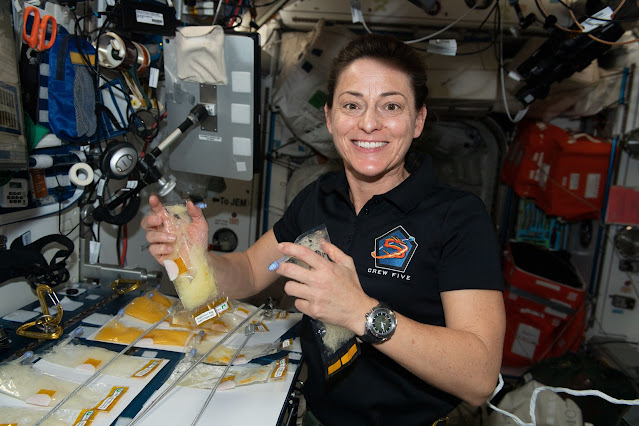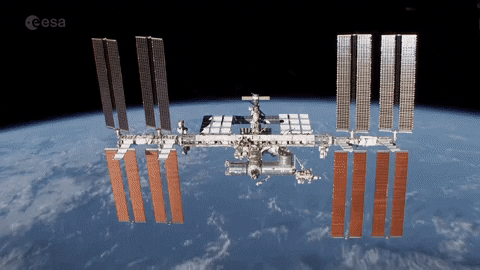ISS - Expedition 68 Mission patch.
Jan 6, 2023
Crew members aboard the International Space Station conducted scientific investigations during the week of Jan. 2 that included testing on-demand production of nutrients, studying microgravity’s effect on a person’s grip, and monitoring microbes in the station’s plant growth habitat.
Here are details on some of the microgravity investigations currently taking place aboard the orbiting lab:
Nutrition in space
Image above: NASA astronaut Nicole Mann holds yogurt bags for BioNutrients-2, an investigation testing a system to produce specific quantities of key nutrients from yogurt, a fermented milk product known as kefir, and a yeast-based beverage. The ability to produce these nutrients in space could help maintain crew health on future long-duration missions. Image Credit: NASA.
Supplying adequate nutrition is one challenge in maintaining crew health on future long-duration space missions to the Moon and Mars, since many vitamins in foods and supplements degrade over time. Producing nutrients during flight could help address this problem and reduce launch mass and volume as well. BioNutrients-2 tests a system to produce specific quantities of key nutrients from yogurt, a fermented milk product known as kefir, and a yeast-based beverage. Results also may provide insight into on-demand production of other biomolecules such as therapeutics and support development of microorganisms that can be revived after long periods of inactivity for a range of applications. On .Earth, the ability to produce vitamins and other biomolecules on demand could help support human health in remote areas and those with limited supply of critical compounds that have a short shelf-life. During the week, crew members hydrated and activated samples for the investigation.
Grip this
Animation above: NASA astronaut Josh Cassada conducts a session for GRIP, an ESA investigation that studies how long-duration spaceflight affects a person’s ability to regulate the force of their grip and trajectory of upper limbs when manipulating objects. Animation Credit: NASA
GRIP, an investigation from ESA (European Space Agency), studies how long-duration spaceflight affects a person’s ability to regulate the force of their grip and trajectory of upper limbs when manipulating objects. These functions developed in Earth’s gravity and can be affected by microgravity. Results could help identify potential hazards for astronauts as they move between gravitational environments and contribute to the design of interfaces for equipment used in these challenging conditions. The research also could provide a better understanding of how the human nervous system controls movement on the ground. During the week, crew members performed seated and supine sessions for the investigation.
Nutritious and safe
The Veggie Monitoring investigation collects microbial samples from the surface of the station’s Veggie plant production system. Samples are returned to Earth for culturing and identification of microbes. Since the Veggie system is open to the cabin environment, to protect the crew and plants from contamination, it is critical to identify which microbes are present and how they may affect the system. This monitoring also produces data useful for evaluating current spacecraft environmental microbial limits. In addition, analyzing the production of safe, nutritious food in the challenging conditions in space could contribute to improved food production in harsh and remote environments on Earth. Crew members performed sample analysis operations for the investigation during the week.
Image above: The snow-capped peaks of active volcano Mauna Loa, bottom, and dormant volcano Mauna Kea, top, on the island of Hawaii are pictured from the International Space Station as it orbits 258 miles above the Pacific Ocean. Image Credit: NASA.
Other investigations involving the crew:
- Particle Vibration, an investigation from ESA, examines the mechanisms of self-organization of particles in fluids. Results could improve our understanding of fluids with dispersed solid particles, which are used in cooling systems for heat exchangers and solar energy collectors in space and in nuclear reactors and electronics on Earth.
https://www.nasa.gov/mission_pages/station/research/experiments/explorer/Investigation.html?#id=8243
- Plant Habitat-03 assesses whether epigenetic adaptations in one generation of plants grown in space can transfer to the next generation. Results could provide insight into how to grow repeated generations of crops to provide food and other services on future space missions.
https://www.nasa.gov/mission_pages/station/research/experiments/explorer/Investigation.html?#id=8336
- Airborne Particulate Monitor (APM) demonstrates an instrument to measure and quantify the concentration of small and large particles in spacecraft air. Air quality is important for keeping astronauts healthy and comfortable, but currently there are no measurement capabilities to ensure that maximum allowable particulate concentrations are met.
https://www.nasa.gov/mission_pages/station/research/experiments/explorer/Investigation.html?#id=7936
- Standard Measures collects a set of core measurements, including data on behavioral health and performance, cellular profiles and immunology, the microbiome, biochemistry markers, sensorimotor changes, and cardiovascular health. These data help researchers characterize adaptive responses to living and working in space and monitor the effectiveness of countermeasures.
https://www.nasa.gov/mission_pages/station/research/experiments/explorer/Investigation.html?#id=7711
- Veg-05 uses the station’s Veggie facility to grow dwarf tomatoes and examine the effect of light quality and fertilizer on fruit production, microbial food safety, nutritional value, taste acceptability by the crew, and overall behavioral health benefits. Growing plants to provide fresh food and enhance the overall living experience for crew members supports future long-duration missions.
https://www.nasa.gov/mission_pages/station/research/experiments/explorer/Investigation.html?#id=7443
Space to Ground: New Year, New Food: 01/06/2023
The space station, a robust microgravity laboratory with a multitude of specialized research facilities and tools, has supported many scientific breakthroughs from investigations spanning every major scientific discipline. The ISS Benefits for Humanity 2022 publication details the expanding universe of results realized from more than 20 years of experiments conducted on the station.
Related links:
Expedition 68: https://www.nasa.gov/mission_pages/station/expeditions/expedition68/index.html
BioNutrients-2: https://www.nasa.gov/mission_pages/station/research/experiments/explorer/Investigation.html?#id=8521
GRIP: https://www.nasa.gov/mission_pages/station/research/experiments/explorer/Investigation.html?#id=1188
Veggie Monitoring: https://www.nasa.gov/mission_pages/station/research/experiments/explorer/Investigation.html?#id=7949
Veggie: https://www.nasa.gov/mission_pages/station/research/experiments/explorer/Facility.html?#id=374
ISS National Lab: https://www.issnationallab.org/
Spot the Station: https://spotthestation.nasa.gov/
Space Station Research and Technology: https://www.nasa.gov/mission_pages/station/research/overview.html
International Space Station (ISS): https://www.nasa.gov/mission_pages/station/main/index.html
Animation (mentioned), Images (mentioned), Video (NASA), Text, Credits: NASA/Ana Guzman/John Love, ISS Research Planning Integration Scientist Expedition 68.
Best regards, Orbiter.ch














































